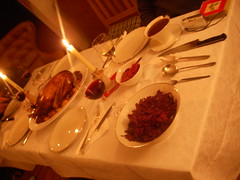Cooking the Goose
Thursday, December 28th, 2006There are three people milling around in a kitchen too small to swing a frying pan in, and two of them are rubbing against you as they flitter between kettle, toaster and fridge. Neither of them are of any help.
You haven’t brought your soup-stick, there’s no fresh parsley and the chestnuts come in a net, not a can. Countdown: four hours ’till Christmas dinner. At six, everyone’s due for a visit at the neighbours. No delays.
It would help to have an idea how much the goose weighs. It rests on a wooden chair, wrapped in white plastic bags. It’s the size of a baby.
And how should it be cooked?
It will come together, it always does. At last, the visitors leave the kitchen, having assembled the breakfast on the dining table. It takes 45 minutes to peel and chop the chestnuts, but that is just enough time to work out a recipe for the stuffing. You make hasty notes on a post-it smeared with butter and breadcrumbs. Meanwhile, the man of the house makes a detour to the neighbours’, standing on their bathroom scales, holding the wrapped goose. Like a baby.
“Eight pounds.”
That is—what? 20 minutes per pound plus twenty minutes. Exactly 3 hours. You grunt contently. “We’re on target. Dinner at 17:00 hours, sharp!”

[read on]








